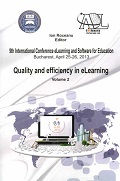VIRTUAL PEDAGOGICAL AGENTS IN THE CONTEXT OF VIRTUAL LEARNING ENVIRONMENTS: FRAMEWORK AND THEORETICAL MODELS
VIRTUAL PEDAGOGICAL AGENTS IN THE CONTEXT OF VIRTUAL LEARNING ENVIRONMENTS: FRAMEWORK AND THEORETICAL MODELS
Author(s): Oana Soica, Cătălin Ştefan, Loredana Manasia, Silviu ApostolSubject(s): Education
Published by: Carol I National Defence University Publishing House
Keywords: virtual pedagogical agents; e-learning; social-cognitive theories; distributed cognition; social interaction; SAPIENT
Summary/Abstract: Teaching and learning are highly social activities. Seminal psychologists such as Vygotsky, Piaget and Bandura have theorized that social interaction is a key mechanism in the process of learning and development. The benefits of peer interaction for learning and motivation in classrooms have been broadly demonstrated also through empirical studies. Hence, it would be valuable if virtual learning environments could support a mechanism for simulating social interaction. Virtual pedagogical agents as animated digital characters might provide an opportunity to simulate such social interaction in computer-based learning. In this paper we ground the instructional potential of pedagogical agents in three social-cognitive theories (distributed cognition, social interaction, and social-cognitive theory) and discuss how specific concepts of the theories might support various instructional functions of pedagogical agents. Based on the theoretical perspectives, we suggest key constituents, roles and functions for designing virtual pedagogical agents. Also, we relate to some instances where these agents were being implemented. We present our vision of designing and implementing such a pedagogical virtual agent in the context of the SAPIENT applied research project (Intelligent Tutoring System-Evolutionary Approach in e-Learning). In the proposed project the virtual pedagogical agent is automatically customized to address several features of each learner, such as appearance, age and gender. The role, appearance, dynamics, communication channels and envisaged behavior of this virtual agent will be discussed along with the possible techniques to be used in its development.
Journal: Conference proceedings of »eLearning and Software for Education« (eLSE)
- Issue Year: 9/2013
- Issue No: 02
- Page Range: 531-536
- Page Count: 6
- Language: English

